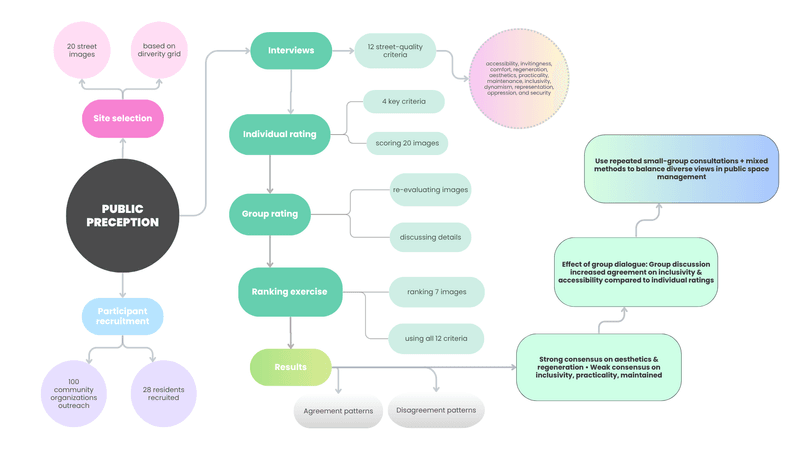From Aesthetics to Access: How Montréalers Rate Their Streets
2025-07-23
Overview
Cities often judge street quality with standardized audits, yet lived experiences vary across gender, age, mobility, culture, and income. This study asks where Montréal residents tend to agree (for instance, on aesthetics) and where they diverge (often on inclusivity and practicality), and how small-group discussion can turn contested ideas into clearer guidance for managers.

Summary of methods and findings for Montréal street perception study.
What we set out to learn
We explored how people describe and evaluate streets, alone and together. The goal was to map the criteria residents actually use, measure where judgments converge or split, and translate those patterns into decisions about design, maintenance, and programming.
How we did it
We conducted 28 semi-structured interviews with community-organization partners to surface twelve recurring criteria people use to talk about streets: accessibility, inviting, comfortable, regenerative, beautiful, practical, maintained, inclusive, dynamic, representative, oppressive, and secure.
Building on that, three mixed-background focus groups (12 participants total) rated 20 curated Montréal street-view images on accessibility, inclusivity, aesthetics, and practicality—first independently, then again after moderated discussion. A separate ranking exercise with 17 participants ordered seven images against all twelve criteria. We assessed convergence and reliability using Pearson correlation, Kendall’s Tau, and intraclass correlation coefficients (ICC).
What we found
Agreement was strongest for qualities tied to visible, shared cues—particularly aesthetics and regenerative features like greenery, coherence, and places that feel restorative. It was weakest or mixed for inclusivity, practicality, and at times maintenance—domains shaped by identity, context, and prior experience.
Crucially, small-group dialogue tightened agreement, especially for accessibility and inclusivity. Discussion helped participants articulate what they meant by “for whom” and “in what situations,” producing more stable judgments than individual ratings alone.
Why it matters for management
Audits work well for physical benchmarks, curb ramps, seating, lighting, shade, where agreement is naturally higher. But for dimensions where experiences diverge, technical checklists aren’t enough. Embedding recurring, small-group consultations into routine management cycles can surface contested meanings early, reduce noise in evaluations, and guide more inclusive choices about design trade-offs, operations, and programming.
Looking ahead
We plan to scale the process across more neighborhoods, invite under-represented cohorts (e.g., teens and Indigenous communities), and test richer media, short videos and 360° views, to better capture flow, noise, and time-of-day change.
Tags: Urban Planning · Public Space · Inclusivity · Participation · Street Perception · Montréal